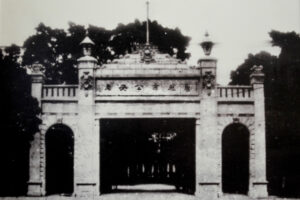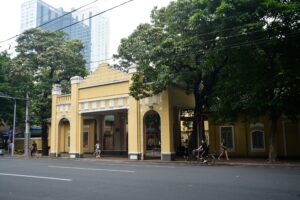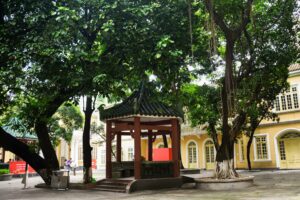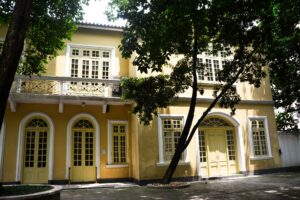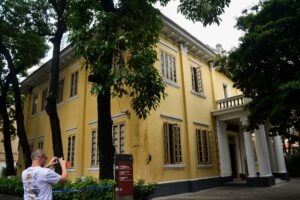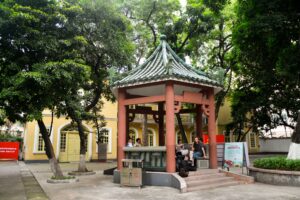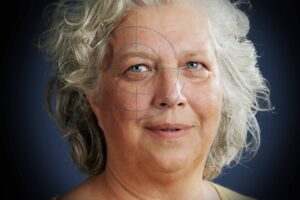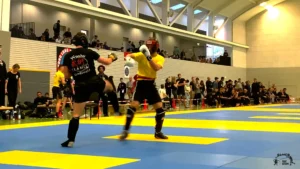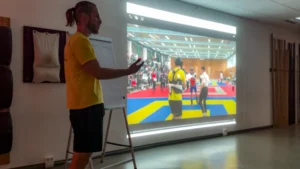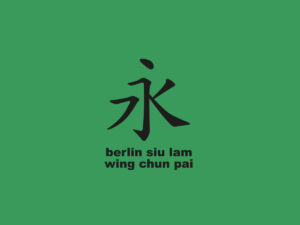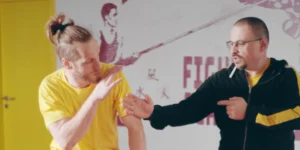Part of the audio recording¹ by GM Tang Yik from the 1960s, translation from Cantonese: Janet Yuen and Peter Scholz. To make the text easier to understand, we have reconstructed some of the dates of the events. We have used the sources listed below.
Style founder
Tang Syun was the most important master within the Wing Chun lineage of the Tang family.
He carried the earlier tradition of Wing Chun Kung Fu into the present and opened up the art for further development.
Tang Syun did not teach in public, even though he brought his kung fu to Hong Kong.
He was very selective about who he accepted as students in Hong Kong.
Having survived and grown over several generations, Tang Family Wing Chun is now practiced worldwide.
Education
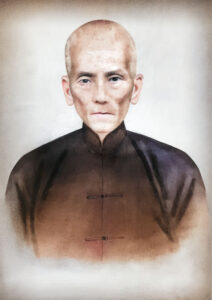
Tang Syun was born at the end of the 19th century as the only son of a well-off family in Xiaotang, Foshan in Guangdong province in China.
At the age of 18, he was unable to pass a state examination due to his poor handwriting.
He was also not at all interested in improving his handwriting, instead he was highly motivated to learn and practise martial arts.
In his early 20s, he began to learn the art from Tang Zau in her home village in Xiaotang.
Tang Zau’s Wing Chun Kung Fu originated from his father Tang Bun, who had learned it from Zen Master Zi Sin at the Feilai Temple in Qingyuan.
Jyun Wo percussion store
After learning the 6.5 long pole and the Wing Chun Kyun hand form from Tang Zau, Tang Syun regularly traveled to the downtown area of Foshan to meet other Kung Fu practitioners in the “Jyun Wo Percussion Store”. The store owner Tang Pok learned the long pole technique of “Gau Dim Sap Saam Coeng” from another student of Zi Sin, Master Long, who had fled from the Babai Mountains in Guangxi. Tang Pok passed on the knowledge of this long pole technique as an effective and powerful method of developing strength. Afterwards, both Tang Pok and Tang Syun learned from Yeung Tim, who was also a Wing Chun practitioner from the Zi Sin lineage, and mastered the Soeng Gung hand form.
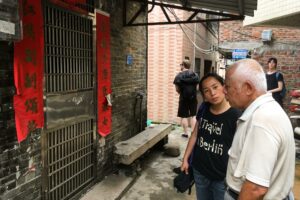
Tang Pok and Tang Syun were businessmen, and that was the reason why they did not need students in public to earn a living like other martial arts teachers did. Nevertheless, the “Jyun Wo Percussion Store” developed into a meeting place where they taught a few people. They were very open to share their knowledge and welcomed Fung Siu Cing, another Wing Chun master, and also some of his students. For example, they taught Dung Zik, Dung Jan and Maa Zung Jyu the long pole. Fung Siu Cing taught the wooden dummy form that he had learned on the Red Junk. Experience was shared within this kung fu group for decades.
Journeys
As the only son of a wealthy family who owned land, businesses and grocery stores, Tang Syun did not have to work hard to earn a living. Admired for his expertise in kung fu, he was invited to teach by numerous neighbors and relatives. He traveled around to teach for free. On one of these trips, Tang Syun ended up in Hunan Fenghuang and met a woman there who had also mastered kung fu. He learned from her and they became good friends. Later, when she had to flee to the south, she settled down at Tang Syun’s home. During her stay, she taught him the whip, some hand techniques and the long pole. After two years, she left and gave him her one-meter-long whip as a souvenir. Tang Syun was now a master of the whip himself.
Tang Syun had heard that Zen Master Zi Sin had fled over the Babai Mountains in Guangxi, so he traveled to the mountains. There he told people that he knew some hand and long pole techniques. This is how he met a man who later came to Xiaotang to trade there.
Family and children
Tang Syun married at the age of 16, and their first child was born two years later. His wife gave birth to a total of five girls. To continue the bloodline, Tang Syun needed a son. With the second wife, who was his distant niece, he fathered six more children. One of them was Tang Yik. Meanwhile, he had another son with his first wife.
One wife, one concubine, 12 children in total. Tang Syun’s concubine, Ms. Lao, came from the Babai Mountains and was also a kung fu practitioner of the Zi Sin lineage. Since she was married to Tang Syun, she continued to learn from him. Later she assisted him in teaching other people.
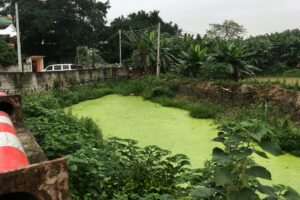
Accident with consequences
In the period from about 1909 to 1910, an accident during a dispute with a village neighbor became a turning point in Tang Syun’s life.
He saw his comrades fighting against the neighborhood over the water resources for farming.
He immediately ran there to help, used the 6.5 long pole and stabbed a man, who then fell into a pothole.
It was not clear whether Tang Syun had killed him with the stick or whether he was killed in the fall.
Tang Syun had to leave his home village.
Hong Kong
Tang Syun fled to Hong Kong, together with his fifth son Tang Jau Jung. His original plan was to go on to Singapore, because he had a friend there who was a vegetable farmer. During the short stop-over in Hong Kong, they stayed in an old inn on the shore. One morning, he went to a Chinese restaurant for breakfast. When he wanted to light a cigarette, he didn’t have a match, so he asked a man at the next table. Tang Syun and the man recognized the accent of their home village and realized that they were both from the Nanhai area. The man’s name was Lei Jat. Lei asked Tang Syun if he knew the famous person from Nanhai Xiaotang called “Tang Syun” because he wanted to learn Tang’s kung fu. At first, Lei Jat could not believe that it was really Tang Syun. They had a little test. Tang Syun simply covered Lei’s hand and Lei couldn’t move at all. Then he was completely convinced. Lei helped Tang Syun to settle down in Hong Kong and introduced him several students. Tang Syun taught a handful of students in Hong Kong, in a room in the backyard of the first floor, Wo On Lane 9, Lan Kwai Fong, in the Central district.
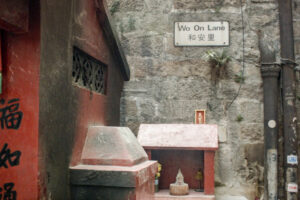
Guangzhou
In 1911 ², Tang Syun saw an opportunity to return to his home village in Foshan: During the collapse of the Qing Dynasty, the imperial army lost influence and many warlords fought each other. After the Xinhai Revolution, the Chinese Revolutionary Alliance declared independence from Guangdong. As a result, Chen Jing Hua³ was appointed as the head of the police station⁴ and he publicly advertised for a police trainer.
The village comrades sent Tang Syun a letter to inform him about this recruitment. If Tang Syun was given this post, it might be helpful to acquit him in the unclear case against him in his hometown. However, he hesitated because of the incalculable risk. Lei Jat and another Wing Chun friend agreed and tried to convince him. Thinking of all his children who were still in the home village, he packed up and left for Guangzhou. When registering for recruitment, he used the name “Tang Gan”. There were 40 other participants and they had to fight with the long pole. After he had fought with some competitors, no one else dared to step forward to fight. So Tang Syun won the battle for the trainer job.
Pictures of the former police station in Guangzhou
Chen Jing Hua
Tang Syun’s superior Chen Jing Hua helped him to settle the long-standing conflict in his home village so that Tang Syun could return to his family in Foshan and teach kung fu at the police station in Guangzhou. Two years later, in September 1913, Chen Jing Hua was murdered³ and the police station was surrounded. Tang Syun decided to leave Guangzhou again.
Chen Jing Hua 陳景華 (1863-1913)
The anti-Qing activist group Chinese Revolutionary Alliance overthrew the Qing dynasty. In 1911, Cantonese military governor Hu Han Min appointed Chen Jing Hua as the police chief of one of the first established police force after the fall of the Qing’s army system. Chen fought brutally against gambling, armed fights, bandits and the mafia, and thousands were arrested and executed. Through his brutal and harsh judgment, the criminal rate was rapidly reduced in turbulent times and chaos was brought under control. Because Sun Yat Sen (leader of the Chinese Revolutionary Alliance, then the first provisional president of the Republic of China) was supported by Chen, their political rival Yuan Shi Kai (first official president of the Republic of China, also tried to restore the monarchy) dispatched the Cantonese warlord Long Ji Guang to kill Chen Jing Hua at the Mid-Autumn Festival night on September 15, 1913. ² ³ ⁴
Back to Hong Kong
Tang Syun was able to save himself and fled to Hong Kong again, this time with his son Tang Yik. During the difficult time of the civil war, Tang Syun lost most of his children or lost contact with them.
Back in Hong Kong, he continued to teach martial arts, still privately at very few independent schools.
He only had a few students as he was very selective.
His students included the calligraphy artist Chan Gaan Jing, the son of a jewelry shop owner Ze Gwan Luk and “Ah Tang”, a lady with a university degree.
His son Tang Yik occasionally helped him teach.
There was a theater in Central called “Kau Yau Fong Theatre”, which was to be demolished on August 1, 1949.
Ze Gwan Luk suggested Tang Syun to give a performance in this theater beforehand to promote kung fu, he would finance it.
Fung Siu Cing heard about the plan and sent his disciples Dung Zik, Dung Jan and Maa Zung Jyu to assist him with the demonstration.
Tang Syun also invited some other masters from Guangzhou to participate.
It was a successful demonstration.
Legacy
Tang Syun died in the early 1950s.
In addition to the Wing Chun Kyun hand form, the Wing Chun wooden dummy, the Soeng Gung, the 6.5 long pole, Hung Kyun and the like, Tang Syun also mastered the whip, the knife and the Waan Tau Dang (bench). He favored the long pole, which he would use in combat against any weapon. His son Tang Yik further contributed to the development of his art and passed on his knowledge. He was successful with the long pole technique and was respected as the “King of the Long Pole”.
Sources
- GM Tang Yik told the story of the origins of Siu Lam Wing Chun Kung Fu of the Tang family in the form of an interview in the 1960s.
This interview was conducted by his student Chan Hoi Syun, in the presence of GM Tang Yik, Chan Hoi Syun and Kwong Chack Cheung, and was recorded on tape. - %E8% (Date accessed: February 20, 2019)
- %85% (Zugriffsdatum: 20. Februar 2019)
- %E5% (Date accessed: February 20, 2019)
